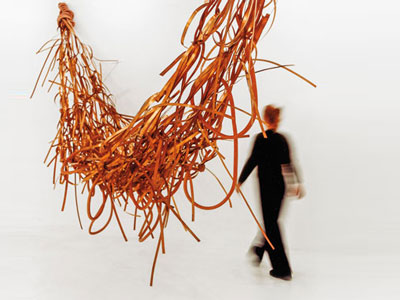Catherine Bompuis
Confrontos
Museu de Arte Moderna, Rio de Janeiro
October 2013
The choice of art works by Frida Baranek for the Museum of Modern Art in Rio de Janeiro obey the desire to make visible a direction first taken in 1984.
From the early works and throughout the years, the relationship that the artist will entertain with the materials consists in defying their resistance to lead them to their metamorphosis: to build with and against it.
Confrontos refers to an attitude as much as to a work process, thus introducing an affective dimension that infuses the object with a lived-in emotion, in a confrontation where to endeavor and to try oneself out appear as constitutive elements of the experience. The existential poetic, the need to confront and to confront oneself without any formal predetermination, reveals the phenomenological approach of these objects. Art and life form a whole that originates within the experience itself. The sculpture of Frida Baranek is the expression of the examination of her perceptive life, her feelings and emotions. Merleau Ponty defines this as perceptive faith, in which to perceive and to imagine are two ways of thinking.
Each object has its own life, is a memory object, and if the question refers to as how to open space within oneself to give it life and make it exist in real space, the third dimension seems to bring them the existential autonomy they claim.
Thirteen sculptures are exhibited in an order that aims to emphasize the relation between the works themselves rather than from a chronological approach.
Two of these works have been produced for the exhibition: Armadilha and Aliança (2013).
Armadilha, a metaphor for human condition, consists of thin iron rods that draw in space a form appearing to be as flexible and elastic as bamboo. In human scale, this trap invites a sense of inner imprisonment.
Aliança consists of twenty iron rings sectioned in its circumference and connected by a brass wire. It does print its graphics in space as well, and a bell ring sounds whenever the rings come to clash. Evocations, images, evanescent fragments of life appear and disappear.
The many residences in foreign countries for over twenty years and the difficulty in transporting bulky and heavy materials not always allowed for the work to be preserved and their reconstitution was essential to make this pathway visible.
Rebuilt for the exhibition, the work Grand Titre (1995 / 2013) opens like a womb onto its own demultiplication: inside, miniature sculptures are inserted into balloons that will gradually lose air and wither during the course of the exhibition until either shattering them or making them disappear. These same miniature sculptures housed in blown glass cling to the piece and the iron rods that come out from it latch on to the ceiling and wall like a strange animal: attraction and repulsion.
References to the body, without ever being illustrative, propose a perceptual, sensory and spatial experience. The work has a lifetime and this principle is opposed to the idea of sculpture as a permanent and immutable object. The process fixes the rules of the game in this melee with matter and exposes their fragility, their disillusionment, while also exposing the possible disappearance of the work.
Bolo (1991), constituted of tangled wires of iron on which marble stones seem to float, cut and sold into twelve parts, was also reconstituted to its original state for the exhibition: Bolão (2013). The process gives it life, but once disassembled, the work returns to its primal state: hundreds of pounds of iron and marble stones.
Frida Baranek’s work thwarts the law of gravity as steel plates folds as single sheets of crumpled paper or iron, steel and marble engineer organic and intimate shape, the experience of so doing each time renewed. Weight and mass are characteristics of sculpture, these same characteristics that the sculpture of Frida Baranek strives toward suppressing, leaving us with the illusion that real was overturned and shows its reverse.
The work Untitled (1985), consisting of two parallelepipeds one above the other in the midst of which are arranged wooden boxes filled with lights that turn on and off alternately is directly inspired by the Vidigal slum. It conveys a feeling of oppression, a reversal of values and imminent danger to those who live, not above, but below.
In such work as Ma Mémoire (1998), latex, first shown dripping in its liquid state, then as a solid and again brought back to its liquid appearance, underlines the interest in the process, as if to show that the work’s formalization stemmed from the interaction of artist and matter. The piece spreads to the ground as a mud puddle in which are caught thread-like sisal tangles. This work is within the limits of sculpture, liquid sculpture, a non-sculpture.
The will to subvert the materials used by industry unveils the extreme fascination they exert on her imaginary. From her training as an architect, which she decides not to pursue in order to devote herself fully and freely to her activities in art, she will always keep intact the interest for structural materials, those which allow to construct, and in her case, to deconstruct.
The use of iron and steel leads at the same time to feelings of both strength and sensuality. Unclassified (1992), work produced for the exhibition Latin American Artists of the XX Century at the Museum of Modern Art in New York, MoMA, in 1993, after itinerancy through Seville, Cologne and Paris, now faces the courtyard of the Museum of Modern Art in Rio de Janeiro in a total antagonism to the great principles governing modernist architecture. Of forms deliberately not defined and towering beyond four meters high, the sculpture consists of a ton and a half of stainless steel in which surplus parts of the U.S. military industry are inlet. This industrial material plays with the analogy of a tropical nature and the military aircraft parts therein imprisoned become reduced to the state of wreckage within a forest of steel.
Latex, sisal, brass, stone, light bulbs, wires, iron rods, plastic, steel, marble dust, are part of the main materials used. Here again it comes to opposing structural and organic materials but the structural ones seem to become organic and the organic, structural.
Certain works play with the image of everyday objects while abolishing their function: a hammock that does not allow one to rest, a closet opened on both sides, a swing on which one cannot sit. The decision to subtract yet recognizable objects of their purpose offers a vision that makes opposites exist only to reveal their paradoxical condition. Their reinscription into the sphere of an imaginary that roots in emotional experience extracts them from reality.
Tenor, Sentimental, Album, Gala, Fatal, Veto, Original, Moral, Brutal (2000) is a series of words common to four languages: English, French, Portuguese and German. Conceived while she lived in Berlin and spoke no German, the work denounces the illusion of things and objects. Born in Rio de Janeiro from a Polish Jewish family victim of the Holocaust, works conceived in Berlin bear the trace of a transmission of memory and the suffering that accompanies it. Deusa imortal (2000), one of the seven closets made by the artist refers to a psychological space where sisal rolls are suspended like a huge mane in a half-open closet where two worlds coexist: the private and the public, personal history and barbarism.
The internal tension of each work defines the visual presence of each piece.
Affinities are perhaps to be sought in the drippings of Pollock, the action and energy it transmits to the pictorial field, in the works of Eva Hesse for their expressiveness or yet in the inner fusion of object and subject so perseveringly sought by Lygia Clark.
This deliberate intuitive approach claims a freedom from the tenets of modernist sculpture.
Modernist sculpture, the one akin to traditional forms of sculpture, is part of the ideological reconstruction of American modernism. Benjamin Buchloh mentioned the “royal road artificially drawn by Greenberg between Parisian Cubism and the U.S. reconstruction of modernism while stating that the history of modernist sculpture is neither as linear nor as homogeneous as its chroniclers and historians or yet balance sheet shaped exhibitions might make it appear.” (1)
XXth century art history has been consistently classifying, reclassifying and declassifying three-dimensional objects according to different system conventions. Would the history of sculpture lend itself, more than other forms of art, to the settling of scores in the history of art criticism? Duchamp was, however, among the first ones to ban from his work the categories of painting and sculpture.
From the sixties on sculpture is no longer isolated from painting, installation or performance and the third dimension is no longer in itself an aesthetic criterion. Lygia Clark, who breaks down the two-dimensional space with Bichos in 1960, introduces a rupture in categories established by the American modernism.
Lygia Clark’s radical experiment to leave the canvas’s surface and move towards space has certainly marked Frida Baranek’s researches deeply.
Full and empty, the death of the plan, the animals, the instant as a proposal, the act, the nostalgia of the body, the capture of suspended time, the body, the stone and the air, man as center and home as body, biological architectures and the collective body, open up new spaces for research and freedom.
Mário Pedrosa’s proposal to replace the non-object with the trans-object in a conversation reported by Lygia Clark in 1960 is premonitory of the research on the permeability of the artistic disciplines that will follow.
“Since also in my expression the plan has been superseded through my own research, what I do would be a new thing about existing categories, for if the informalists get out through the relief and we get out for the space, it is obvious that the business about categories is running out, and the issue left is the one around the name non-object, which could generate an impasse. Mário Pedrosa thinks that trans-object suited the plastic arts since the transcendence still comes from the object itself.” (2)
Foreign to theoretical debates on the art object, the work of Frida Baranek makes no statement about its status and its future. Buried in the depths of its intimacy it refers us to its impenetrability, its fragilities, balances and imbalances that remain unanswered: It is what it is.”
It is therefore from this perceptual experience that we experience our own perception.
The exhibition must be able to account for this singular experience, singular in time – or, rather, in the time of the work – and to share it.
(1) Benjamin H. 0. Buchloh. Construire (l’histoire de) la sculpture. Exhibition’s Catalog. Qu’est-ce que la sculpture moderne? Georges Pompidou Centre. MNAM. Paris.1986.
(2) Lygia Clark, 1960. Lygia Clark’s Exhibition Catalog. Tapies Foundation. Barcelona, 1997, p. 141.
© Catherine Bompuis
In: Frida Baranek, Confrontos. Rio de Janeiro: MAM RJ, 2013. (exhibition catalog)
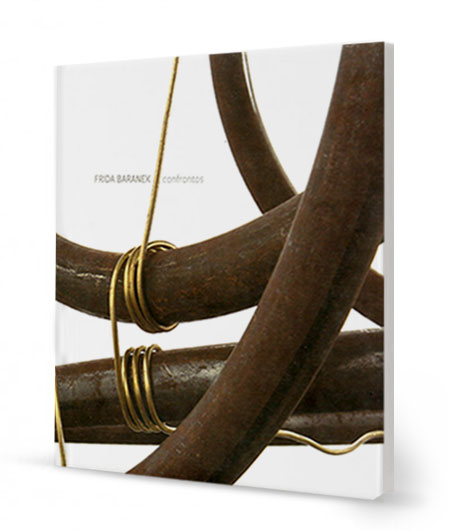
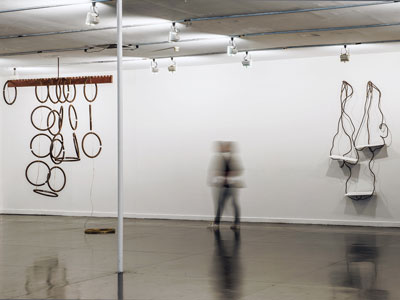
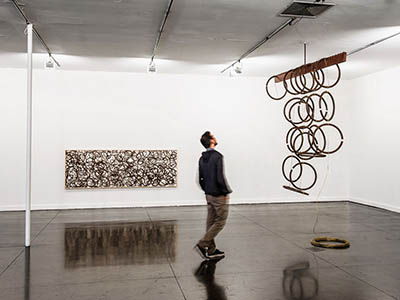
Exhibition view, MAM-RJ, 2013
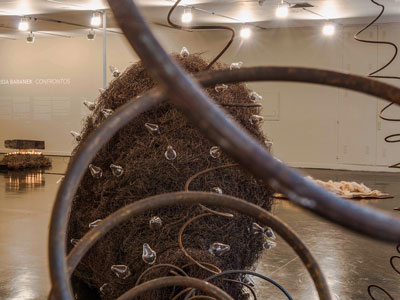
Grand Titre, 1995-2003
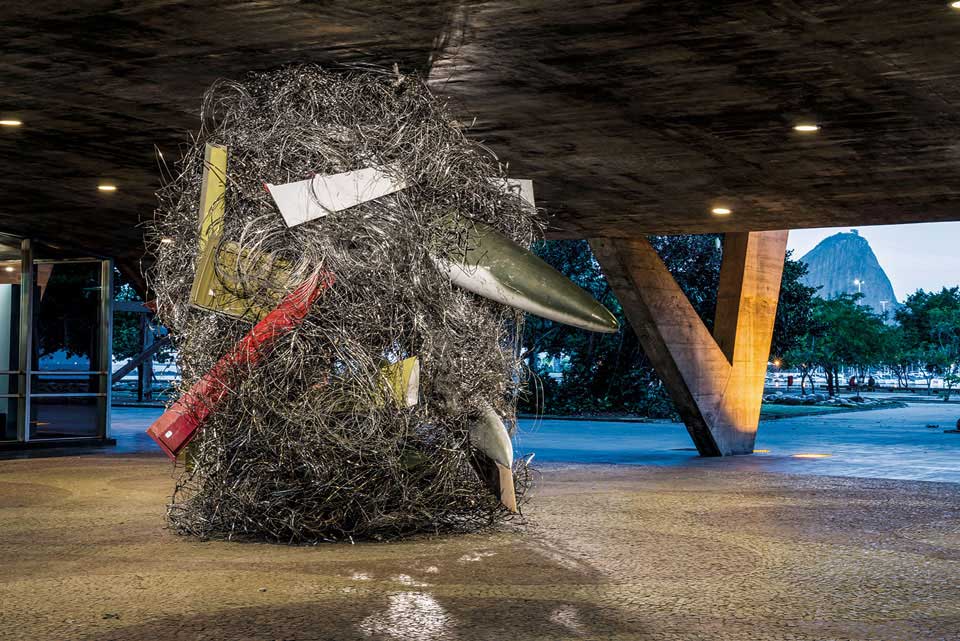
Unclassified, 1992
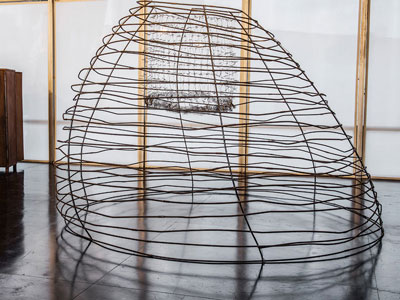
Armadilha, 2013
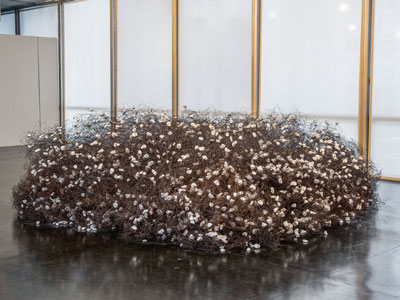
Bolo/Bolão, 1990-2013
